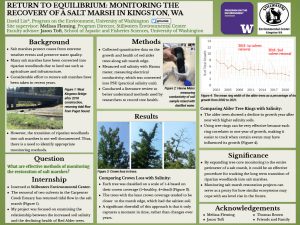Monitoring the Recovery of a Salt Marsh in Kingston, WA
Salt marshes are essential ecosystems for protecting coasts from extreme weather events by reducing erosion from floods and hurricanes, and for filtering pollutants that preserve water quality. Urban development along coastal areas has led to insulation of wetland ecosystems due to bridges with narrow underpasses, severely limiting the amount of water that can flow in from the sea. Over time, the lack of water converts wetlands into non-tidal riparian forests (near a body of water), and makes coastal communities more vulnerable. More recently, substantial efforts have been made to restore wetland ecosystems to their former state. However, the changes that have resulted in these projects are not well documented. The aim of this study was to evaluate the methods for which we can track these changes over time. This was accomplished by collecting quantitative data of red alder trees and the salinity of the soil near them along the Northwest edge of the Carpenter Creek salt marsh. Through analysis of tree ring widths and salinity of soil samples, my results found a positive correlation between the salinity of the soil and the decline of the alder tree’s health. This study provides a proof of concept on how agencies like Stillwaters might evaluate the recovery of a salt marsh from the return of tidal inundation. A greater significance may be to evaluate how the exposure of riparian forests to sea water may serve as a proxy for how sea level rise may affect similar ecosystems in the future.
